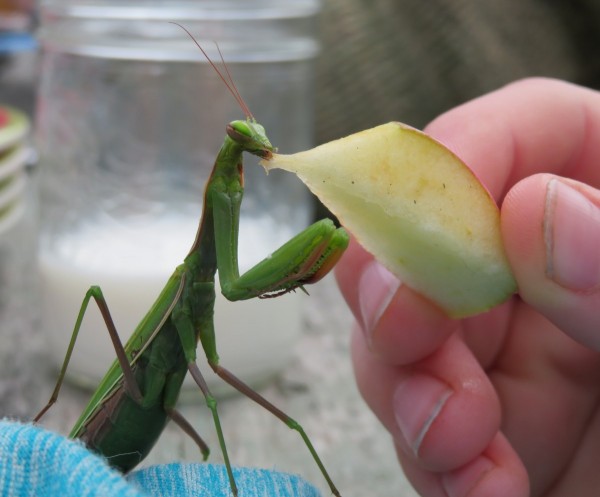
Not an Inflatable Hallowe'en Prop Estonian Life
FOTO 1:
With all of the täis/puhutud (inflated) ämblikud (spiders) out there right now, it's hard to tell what's päris or ehe (real) and what is a prop or decoration (kuliss). This palvetaja aka palvetaja/ritsikas (praying mantis) is very real and very much resembles a tulnukas (alien), some/one or -thing that has tulnud (come) from afar. It is a liha/sööja (carnivore) and either is craving moisture from this piece of apple or is too polite to refuse trying it. We did, after all, invite him/her to our outdoor breakfast table near Lakefield Ontario on 20. oktoober. It was no doubt nearing the end of its elu/ring (life cycle).
If you've been out and about in residential neighbourhoods recently, you've noticed the kaunistused (decorations) in anticipation of Hallowe'en. The first half of the word kaunistused, kaunis, means beautiful, which might not quite reflect the current mood. The opposite or antonüüm of kaunis is kole and koletised are monsters – that works! (Beauty and the Beast = Kaunitar ja koletis.) But there's no verb "kolestamine" or "uglify". Õudustama? Make horrific? Perhaps deform, degrade? Lagunema, lagunduma is to break down or fall apart, including the process of decay. Laga (swill, also a mess) and/or löga can be left behind after something has fallen apart or rotted. Yuck! Rõve! Grotesque!
Õudne / õudus is terrible, gruesome, horrible – horror! A horror movie = õudus/film or õudukas for short. Hallowe'en's keyword is õudne. Kids from Eesti, who have not yet experienced the holiday as such firsthand (trick or treating), have reacted to stores selling Hallowe'en nänn (paraphernalia) including decorations and costumes with: "Ma ei arvanud, et see nii hull on!", (I didn't think it (the holiday) would be this crazy!), i.e. hirmu/äratav – frightening and in such abundance. I didn't either, because when I was a little kid in Toronto, referring to Hallowe'en in daily conversations at home as mardi/päev, the closest equivalent, a (ONE!) kõrvitsa/latern (jack-o-lantern) was the norm. Or you made your own tont / kummitus (ghost) out of a voodi/lina (bed sheet) at best. Or visited a special kummitus/maja (a haunted house). ("Seal majas kummiTAB" – That house is haunted.) You could not buy a screaming, plastic, blow-up, flames of hell Hallowe'en world to erect on your doorstep like today. "So much more was left to the imagination," I keep telling them. And I'm not going as far back as the era of "Roheliste Viilkatuste Anne" (Anne of Green Gables).
Enter the hypnotizing, mesmerizing mantis. From the Old World! European mantis, latin Mantis religiosa, with some "horrific" habits, such as sexual cannibalism... Hmmm. But it all makes sense, to her and her future pesa/kond (brood). Kind of a good reminder to keep calm, keep it real and see the big picture – check out the history and intersecting paths of the various souling traditions. Hallowe'en spookiness is great and the theatrics are fun, but as in the case of the Mexican Día de Muertos, Day of the Dead on Nov. 2, death and spirits need not be a thing to fear or make gruesome; they can be colourfully commemorated in a demonstration of love and respect for deceased family members.
In Estonia, I dare say people would shudder at the thought of erecting fake tombstones in their yard, since it would make light of those who have passed away. Estonian humour is dark, but in a whole different, ironic way. They go to the cemetery on Nov. 2, hingede/päev, All Souls' Day and place a candle on the graves of their beloved departed. Or light a candle in the window at home, symbolically inviting the spirits of foreparents home, or go to a concert, church service, or visit a hiis (sacred grove) during the quiet moments of fall that souls are on the move (okt.-jõulud). "Running" or souling as a Mart or Kadri mummer comes in Nov. and the "costumes" are DIY-to the max. (Pre-Christmas mumm(er)ing is still alive and well in Newfoundland.)
Sure, Hallowe'en, (which I cannot write without the apostrophe because that's how we were taught at school, as a contraction of the original All Hallow's Evening), need not be taken too seriously, and two girls from Eesti are eager (and a bit anxious) to participate this year, just as I loved it in my time, but I can't help but look at the mountains of merchandise: plastic bones, blinking skulls and sugary downpours (slime?) through my udused (foggy), take-it-down-a-notch Estonian spectacles... I look at all the pumpkins and wonder how much of their flesh will actually be ingested (Oh, õudust! Horror!) Jack-o-lanterns are beautiful, but to me, pumpkins scream one thing above all else: KÕRVITSA/PÜREE/SUPP!
P.S. An oft-used, mõistlik (sound, sane) Estonian expression to remember: "Parem õudne lõpp, kui lõputu õudus." A horrific end is better than endless horror.
Read about the first praying mantis to reach Eesti this past summer: https://blog.ut.ee/new-souther...
Riina Kindlam
PHOTO 2: Seeing a palvetaja (praying mantis) can be considered hea õnn (good luck) depending on your culture. Because of its "praying hands", some Christians interpret this putukas (insect) as representing spiritualism or vagadus (piety), and if found in your home, may mean that inglid (angels) are watching over you. Other symbolisms include kannatus (patience), rahu (calm(ness)), intuitsioon, tasa/kaal (balance) and kohal/olek or ärksus (mindfulness). Fear not, they are incredible creatures. What we should fear is climate warming – the reason behind the first mantis being found as far north as Estonia in 2019?
Photos: Riina Kindlam
Arvamus
TRENDING


























